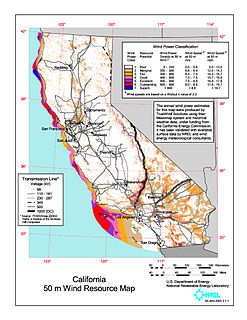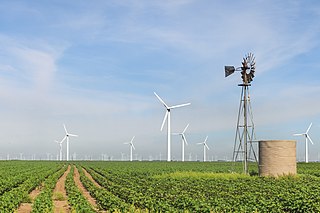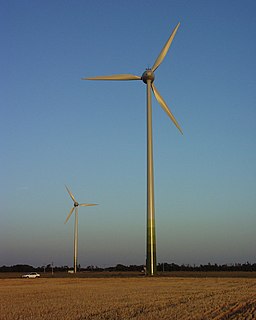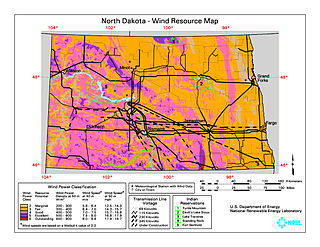As of 2016, there were over 160 operational wind farms in Lithuania, but the majority of them consisted of small farms generating less than 2 MW. [1]
Only farms with bigger than 3 MW capacity are listed.
| Name | Capacity (MW) | Comments |
|---|---|---|
| Akmenėliai Wind Park | 6 | |
| Benaičiai-1 Wind Park | 34 | |
| Berlainiai Wind Park | 4 | |
| Čiūteliai Wind Park | 39.1 | |
| IKEA Group Wind Park | 45 | |
| Didšiliai Wind Park | 16 | |
| Didšiliai-474 Wind Park | 5.4 | |
| Dolomitas Wind Park | 6 | |
| Kreivėnai Wind Park | 20 | |
| Kreivėnai-II Wind Park | 10 | |
| Kreivėnai-III Wind Park | 14.9 | |
| Kunigiškiai Wind Park | 7.5 | |
| Laukžemė Wind Park | 16 | |
| Lendimai Wind Park | 6 | |
| Liepynė Wind Park | 9.13 | |
| Mockiai Wind Park | 12 | |
| Pagėgiai 13 | 73.5 | Biggest wind farm in Baltic States |
| Pakertai Wind Park | 6 | |
| Relit Wind Park | 4.9 | |
| Renerga–1 Wind Park | 7.5 | |
| Rotuliai-II Wind Park | 24 | |
| Seirijai Wind Park | 6 | |
| Sūdėnai Wind Park | 14 | |
| Šilalė Wind Park | 13.8 | |
| Vydmantai Wind Park | 30 | |
| 4Energia Wind Park | 60 | |

The Portland wind farm is one of Australia's largest wind farms. Located on the coast of south-western Victoria near the city of Portland, it consists of four separate sites, all of which have been completed as of 2015. Completion of the entire 195 MW project was expected in 2011, at a capital cost of A$330 million.
Wind power is a form of renewable energy in Pakistan which makes up more than 6% of the total electricity production in the country. As of 2018, wind power capacity in Pakistan was 1,287 MW. The government is looking to increase the share of renewable energy and plans to add around 3.5 GW of wind energy capacity by 2018.

As of December 2017, installed capacity of wind power in the European Union totaled 169.3 gigawatts (GW). In 2017, a total of 15,680 MW of wind power was installed, representing 55% of all new power capacity, and the wind power generated 336 TWh of electricity, enough to supply 11.6% of the EU's electricity consumption.

Wind power in California had initiative and early development during Governor Jerry Brown's first two terms in the late 1970s and early 1980s. The state's wind power capacity has grown by nearly 350% since 2001, when it was less than 1,700 MW. In 2016, wind energy supplied about 6.9% of California's total electricity needs, or enough to power more than 1.3 million households. Most of California's wind generation is found in the Tehachapi area of Kern County, California, with some large projects in Solano, Contra Costa and Riverside counties as well. California is among the states with the largest amount of installed wind power capacity. In recent years, California has lagged behind other states when it comes to the installation of wind power. It was ranked 4th overall for wind power electrical generation at the end of 2016 behind Texas, Iowa, and Oklahoma. As of 2019, California had 5,973 megawatts (MW) of wind power generating capacity installed.

The Roscoe Wind Farm near Roscoe, Texas is one of the world's largest-capacity wind farms. With 627 wind turbines and a total installed capacity of 781.5 MW, owned and operated by RWE. At the time of its completion in 2009, it was the largest wind farm in the world, surpassing the nearby 735.5-megawatt Horse Hollow Wind Energy Center. In 2012, it was overtaken by California's 1,020-megawatt Alta Wind Energy Center.

Solar power represented a very small part of electricity production in the United Kingdom until the 2010s when it increased rapidly, thanks to feed-in tariff (FIT) subsidies and the falling cost of photovoltaic (PV) panels.
The Capricorn Ridge Wind Farm is located in Sterling and Coke counties, Texas. It is a 662.5 MW wind farm, with 342 GE 1.5 MW wind turbines and 65 2.3 MW Siemens turbines that are capable of generating enough electricity for more than 220,000 homes. The wind farm is built, owned and operated by a subsidiary of NextEra Energy Resources, the U.S.' largest wind energy generator. The project is part owned by San Antonio-based Sullivan Trillian Fund Private Equity.
Wind power in Indiana was limited to a few small water-pumping windmills on farms until 2008 with construction of Indiana's first utility-scale wind power facility, Goodland with a nameplate capacity of 130 MW. As of September 2017, Indiana had a total of 1897 MW of wind power capacity installed, ranking it 12th among U.S. states. Wind power was responsible for 4.8% of in-state electricity production in 2016.

Wind Power in Pennsylvania, one of the major source of renewable energy, it accounts for over one third of the renewable energy production of Pennsylvania. There are more than 27 wind farms currently installed in the commonwealth of Pennsylvania. These 27 farms on average could provide power for nearly 350,000 homes or 1,300 megawatts of energy. A majority of these wind farms are located in the southwest-central and northeastern regions of the state. Pennsylvania is an East Coast leader in wind energy due to its natural wind resources and governmental incentives brought on by the state. There is a lot of potential for growth within the wind power industry in Pennsylvania and the Northeast. Pennsylvania is close to several offshore sites along the coast of the Atlantic Ocean.

Alta Wind Energy Center (AWEC), also known as Mojave Wind Farm, is the third largest onshore wind energy project in the world. The Alta Wind Energy Center is a wind farm located in Tehachapi Pass of the Tehachapi Mountains, in Kern County, California. As of 2022, it is the largest wind farm in the United States, with a combined installed capacity of 1,550 MW (2,080,000 hp). The project, being developed near Tehachapi Pass Wind Farm— site of the first large-scale wind farms installed in the U.S. in the 1970s and 1980s—is "a powerful illustration of the growing size and scope of modern wind projects".

The US state of Colorado has vast wind energy resources and the installed electricity capacity and generation from wind power in Colorado has been growing significantly in recent years. The growth has been sustained due to a combination of falling costs, continuing federal incentives, and the state's aggressive renewable portfolio standard that requires 30% of the state's electricity to come from renewable sources by 2020.

The installed capacity of wind power in Hungary was 329 MW as of April 2011. Most of wind farms are in the Kisalföld region.

North Dakota is a leading U.S. state in wind power generation. The state generated 26.8% of its electricity from wind during year 2017, enough to power over one million homes.

Solar power in New York includes the largest solar farm on the east coast, the 37 MW Long Island Solar Farm, as well as the 17 MW enXco Eastern Long Island Solar Project, which consists of seven projects, three at LIRR station carports.

Solar power in Indiana has been growing in recent years due to new technological improvements and a variety of regulatory actions and financial incentives, particularly a 30% federal tax credit for any size project.

Solar power in Lithuania is a form of renewable energy in Lithuania, and created 39 GWh of electricity in the first nine months of 2013. At 2020 Lithuania had capacity of 148 MW of solar power.

Wind power in Michigan is a developing industry. The industrial base from the automotive industry has led to a number of companies producing wind turbine parts in the state. The development of wind farms in the state, however, has lagged behind. In January 2021, there were a total of 1,481 wind turbines in the state with a nameplate capacity of 2,549 MW. The nameplate total exceeded 2,000 MW when Pine River came online in March 2019. Wind provided 4.2% of the state's electricity in 2016.
As of the end of 2016, New Mexico had 1,112 megawatts (MW) of wind powered electricity generating capacity, responsible for 11% of electricity produced that year. Wind power in New Mexico has the potential to generate more than all of the electricity consumed in the state.

As of 2021 there is little solar power in Belarus but a lot of potential as part of the expansion of renewable energy in Belarus, as the country has few fossil fuel resources and imports a lot of energy. At the end of 2019 there was just over 150MW.
The Limon Wind Energy Center is a 600.6 megawatt (MW) wind farm in eastern Colorado near the town of Limon. It became the largest wind facility in the state when construction completed in 2014. The electricity is being sold to Xcel Energy under long-term power purchase agreements.